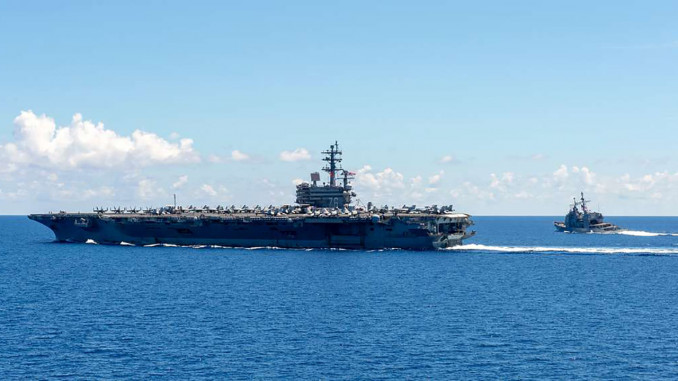
The South China Sea is the site of continuous conflict between the U.S. and China. This body of water located off China’s southern coast has been the location of continuous military buildup by China over the last ten years, and U.S. military aggression in response.
China has built up underwater reefs into new islands and planted airfields, bases, and missile systems on them. Not only is the South China Sea the site of Chinese military presence, it is estimated to contain 11 billion barrels of oil, 190 trillion cubic feet of natural gas, and ten percent of the world’s fishery resources. The sea is also an important economic trade route, with 30 percent of global trade via waterways passing through it.
Contested Boundaries
Who is entitled to rule the South China Sea? Of course, neither of these exploitative states should rule, but even between them they don’t agree.
China lays claim to the South China Sea based on historic Chinese territories stretching back to the 13th century. However, other states such as the Philippines, Vietnam, Brunei, Taiwan, and Malaysia also lay claim to the South China Sea and its islands. During Japan’s imperial expansion in the first half of the 20th century, much of the territory was controlled by the Japanese. During this period, China was suffering from the aftermath of more than a century of British domination, followed by failed popular revolutions, Japanese invasion, and internal civil war, and had no means to exert control over the Sea. After World War II, in 1951, the San Francisco Treaty presided over by the U.S. forced the defeated Japanese empire to give up control and the South China Sea was again up for grabs.
China’s Current Claim
In 1947, the then Chinese government had drawn a map that claimed China’s historic right to control 90 percent of the South China Sea. At the time, the United States recognized this claim. Within two years, the Chinese Communist Party led by Mao Tse Tung would take control of China in the 1949 Chinese Revolution. The Communist Party maintained that it deserved the same right to control the South China Sea as its predecessor, while giving up control of Vietnam’s Gulf of Tonkin. However, by this time Malaysia, the Philippines and Taiwan all claimed control over portions of the South China Sea and its islands. Today, the U.S. insists on the rights of these states against China, even though it had agreed to China’s original claim in 1947. It’s no surprise these states all have military and economic alliances with the U.S. or are sites of U.S. military bases. In other words, when the U.S. speaks about standing up for so-called international law while at the same time denying China’s previous claims to the South China Sea, it is being selective about which rights and whose rights are recognized.
Sabre Rattling on Both Sides
For years now, the U.S. and its military allies have undertaken provocative military exercises in the South China Sea. For example, the Rim of the Pacific (RIMPAC) military exercises, conducted since 1971, have gathered naval forces from all over the world to prepare for a conflict in the region. The latest RIMPAC exercise involved 26 countries using 38 major naval ships, four submarines, 170 aircraft, and armed forces from nine armies. These war games are set up to prepare for the real thing.
Later that year, China’s Shandong aircraft carrier group carried out what it called “realistic combat-oriented confrontational exercises.” Chinese aircraft carriers and jet fighters simulated their response if combat were to break out between the U.S. and its allies, on one hand, and the Chinese navy. At the same time, the U.S. Nimitz carrier group conducted its own exercises in the South China Sea.
On the Brink of Conflict
Both sides are pushing the situation to the brink of conflict. Last December, a Chinese fighter jet intercepted and harassed a U.S. surveillance plane over the South China Sea, and last November, the Chinese navy chased off a U.S. naval ship near the Spratly Islands. Most recently, of course, the U.S. intercepted and shot down a suspicious Chinese weather balloon in airspace near Alaska.
The lines are already drawn for a massive conflict between the U.S. and its allies, and China. Both sides are driven by wealthy elites who aim to control the South China Sea and its resources and strategic value. Humanity has no stake in this rotten game. We oppose this escalating military conflict with its deadly implications for every living thing on this planet!




